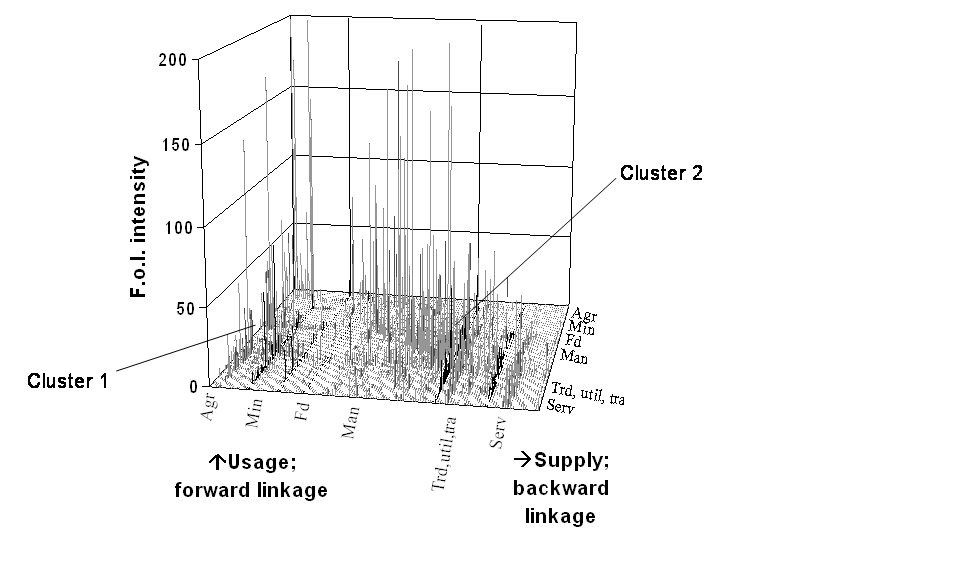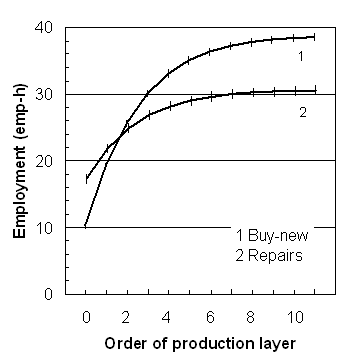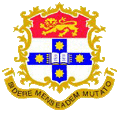|
|
Economic Systems
Research
Research on economic systems and how they are linked with the
physical world underpins our approaches to applied fields such as
Triple Bottom Line / Sustainability Reporting, Ecological Footprints or
Environmental Impact Assessment.
Examples for systems studies include
- International carbon trade flows: In order to achieve
equitable reduction targets, international trade has to be taken into
account when assessing nations responsibility for abating climate
change. Especially for open economies such as Denmark, greenhouse gases
embodied in internationally traded commodities can have a considerable
influence on the national greenhouse gas responsibility. We have
constructed a five-region interindustry model including Denmark,
Germany, Sweden and Norway in order to calculate CO2 multipliers and
trade balances. In the case of Denmark, carbon trade feedback between
these countries results in a carbon deficit, that is, Denmark imports
more carbon than it exports. From a methodological point of view, both
the type of model and the degree of aggregation are crucial parameters
when calculating CO2 responsibilities of countries. Considering
consumer rather than producer responsibility for carbon emissions could
have a major bearing in international negotiations. This study is carried out in collaboration with AKF Institute of Local Government Studies in Copenhagen, Denmark, and funded by the Danish Energy Agency.
- Linkages and key sectors: We have extended traditional work
on linkages, fields of influence and structural paths in order to
include environmental and natural resource parameters, and developed
the theoretical basis for the generalisation of all three concepts.
Applying these extended linkage and key sector concepts to recent
Australian empirical data on energy consumption, land disturbance,
water use, and emissions of greenhouse gases, NOx and SO2 reveals the
interdependence of industries in the Australian economy in terms of
environmental pressure and resource depletion. Grazing industries,
electricity generation, metals, chemicals, textiles, meat and dairy
products, wholesale and retail, non-residential building, and
hospitality exhibit above-average linkages. A considerable part of
environmental and resource pressure is also exerted along paths for
providing exports. As an example, the figure below shows an economic
landscape representing the field of influence of transactions between
industries in the Australian economy, in terms of greenhouse gas emissions. Two clusters of strong linkages in greenhouse terms can be identified: Cluster 1 represents emissions caused by land clearing and agriculture that become embodied in products of the food manufacturing sector; Cluster 2 contains energy-related emissions associated with supplies from heavy industries and power plants to other manufacturing sectors.
 Economic landscape of the
Australian economy, in terms of greenhouse gas emissions.
- Upstream convergence and cross-overs in ranking and
benchmarking: As impacts propagate in an upstream direction through
economic systems, their magnitude diminishes, and the total impact
converges to a final value, representing system completeness. There is
strong evidence for differential convergence of impacts towards
system completeness. This differential convergence can cause
cross-overs at second- and higher-order upstream production layers in the
ranking of impacts for products, projects or companies (see the example below for the employment impact associated with the alternative options of buying a new car versus car repairs). The exclusion of higher-order upstream impacts can be responsible for these ranking
cross-overs going unnoticed. In this case, an incomplete conventional
process-type assessment of two alternative products, projects or
companies can result in preferences and recommendations to
decision-makers that are different from preferences and recommendations
concluded from a complete, whole-supply-chain assessment. In order to
provide fair comparisons and benchmarking, misleading effects of
ranking crossovers have to be detected. This is only possible if the entire upstream supply chain of products, projects or companies is taken into consideration.
 Convergence of
cumulative labour requirements for a A$1,000 expenditure on a new
vehicle and on vehicle repairs, in units of employment-hours (emp-h).
- Structural Path Analysis: Methods for TBL Reporting,
Ecological Footprints, Life-Cycle Inventories or Environmental Impact
Assessment employing input-output analysis have advantages over
conventional approaches. A technique called Structural Path Analysis can "unravel" TBL
impacts, ecological footprints etc into single contributing supply
paths. It gives extensive detail of the impact of a product, process,
project, company or sector. It allows investigating the location of
impacts within the supply chain. This technique was applied to recent
Australian data in order to determine environmentally important input
paths in terms of energy consumption, land disturbance, water use, and
emissions of greenhouse gases, NOx, and SO2, for all Australian
industry sectors. Due to the complexity of inter-industrial
transactions, up to third-order paths can be top-ranking. The
identification of such paths is usually beyond the capability of
conventional techniques.
- Uncertainty calculus and error
propagation in input-output systems: Conventional
process-analysis-type techniques for compiling TBL Reports, Ecological
Footprints, Life-Cycle Inventories or Environmental Impact Statements
suffer from a truncation error, which is
caused by the omission of resource requirements or pollutant releases
of higher-order upstream stages of the production process. The
magnitude of this truncation error varies with the type of product,
process, project, company or sector considered, but can be in the order
of 50%. One way to avoid such significant errors is to incorporate
input-output analysis into the analysis framework. Using Monte-Carlo
simulations, it can be shown than uncertainties of input-output-based
assessments are often lower that truncation errors in even extensive,
third-order process-type analyses.
For further information contact us for copies of journal
articles on
- Linkages and key sectors: Lenzen M, Environmentally important
linkages and key sectors in the Australian economy, Structural
Change and Economic Dynamics, 14 (1), 1-34, 2002,
- Convergence
and crossovers in upstream life-cycle inventories: Lenzen M and Treloar
G, Differential convergence of factor requirements towards upstream
production stages Implications for life-cycle assessment, Journal
of Industrial Ecology 6 (3-4), 137-160, 2002,
- Developing
Structural Path Analysis: Lenzen M, A guide for compiling inventories
in hybrid LCA: some Australian results, Journal of Cleaner
Production, 10, 545-572, 2002,
- Uncertainty calculus and error
propagation within input-output systems: Lenzen M, Errors in
conventional and input-output-based life-cycle inventories, Journal
of Industrial Ecology 4 (4), 127-148, 2001.
For further information please contact
|
Dr Arne Geschke
ISA, School of Physics A28
The University of Sydney NSW 2006
+61 (0)2 9036-7505
[email protected]
|
|



